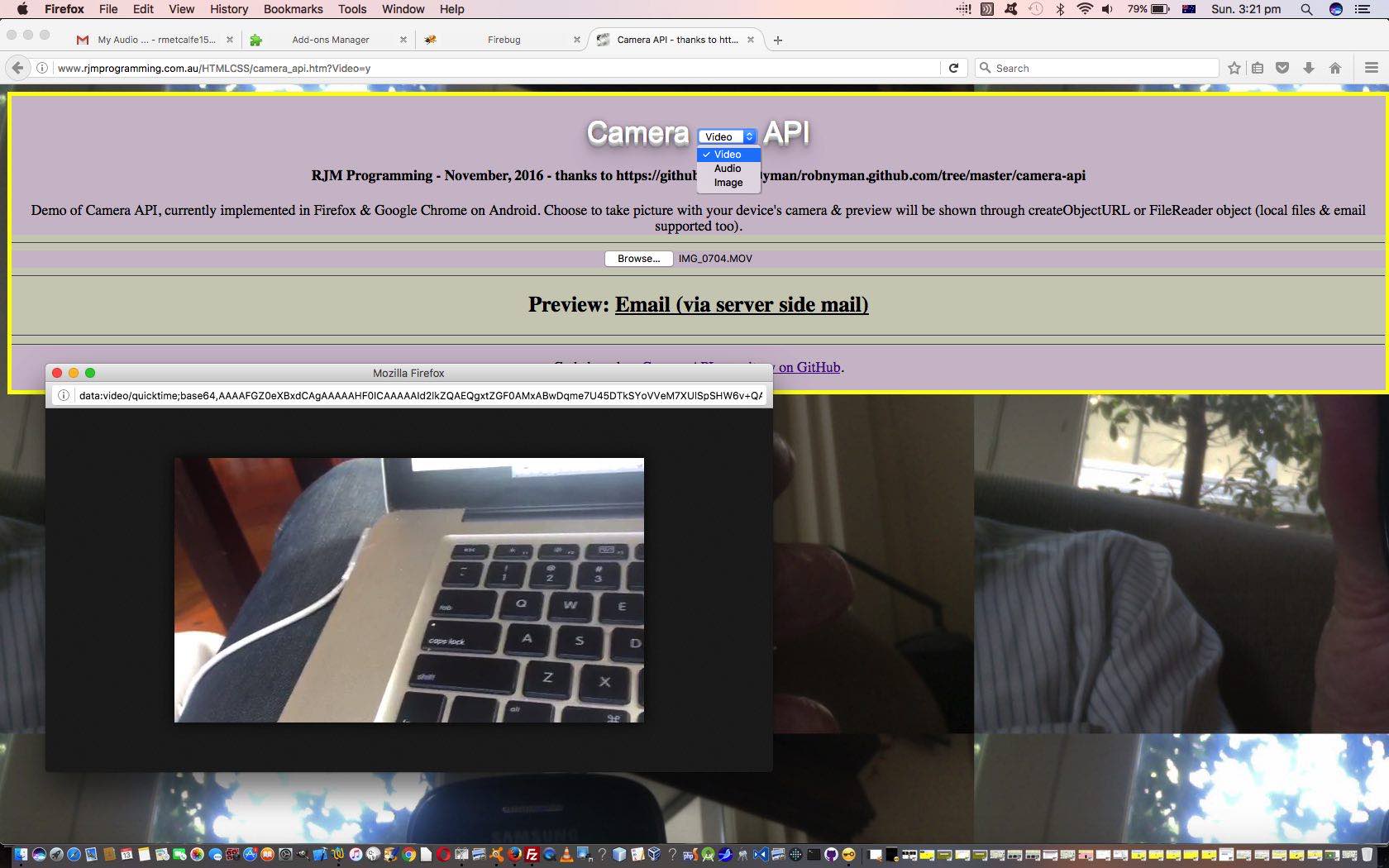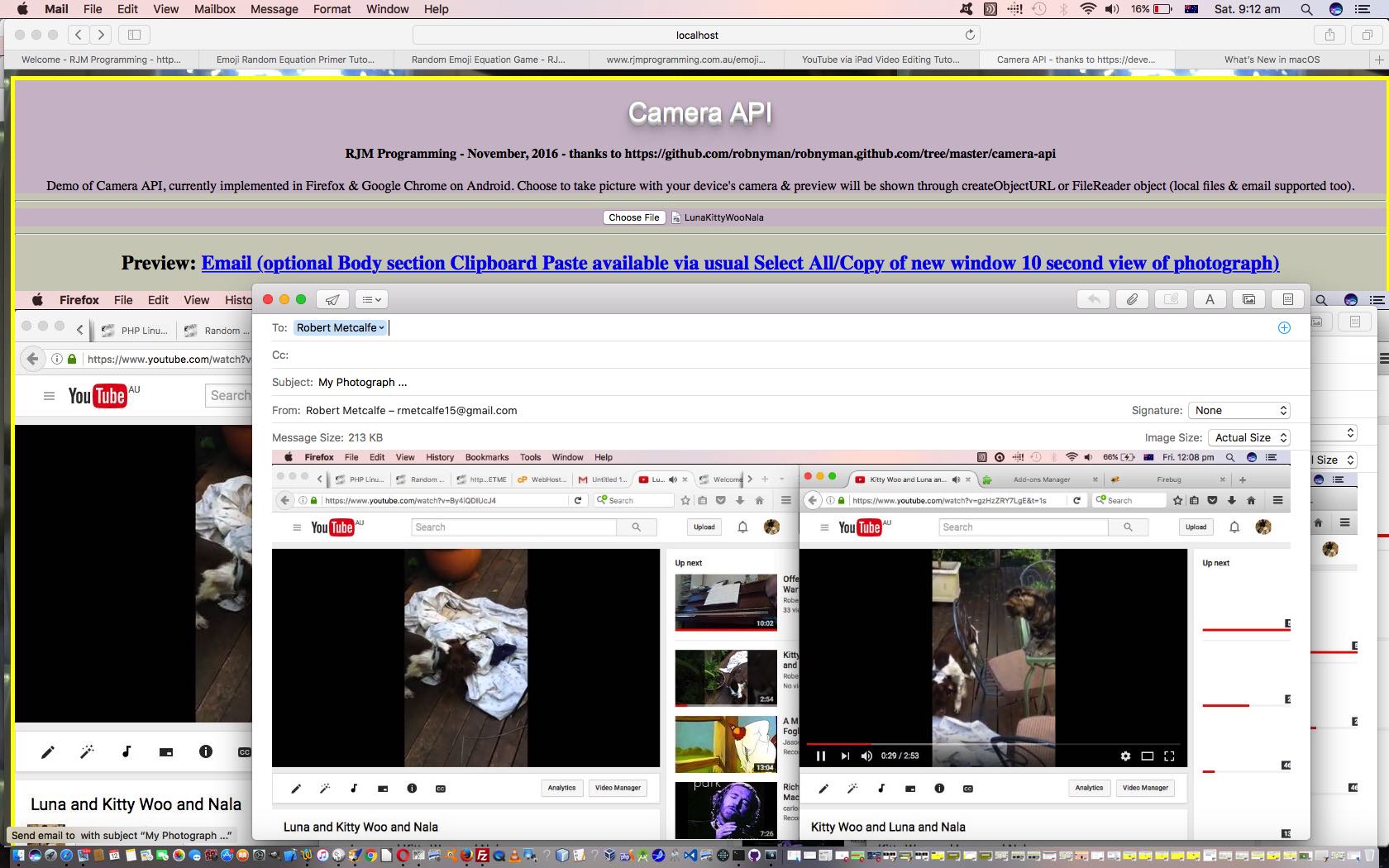Yesterday we started down the line of examining the Camera API in HTML5 with HTML5 Camera API Primer Tutorial as shown below.
There we thought of the “Camera” being a camera of “Images”, but most modern smart phones or tablets have a Camera app that can capture …
- Video
- Audio
- Image
… media sources.
These two new media sources “Audio” and “Video” above need the intervention of a PHP server side emailer functionality in order to send out HTML emails with data URI “src=” HTML elements for these two types of media data.
How do we work this for the user using this web application? We allow the “media sources” above be part of an HTML “select” dropdown and separate the choices in the predominantly Javascript DOM “client feeling” code via the use of “document.URL” logic control (of Javascript DOM document.write() method) as per this …
<script type='text/javascript'>
if (document.URL.toLowerCase().indexOf('video') != -1) {
// Video specific logic ... eg. ...
document.write('<input onclick="document.getElementById(' + "'" + 'aemail' + "'" + ').style.display=' + "'" + 'inline' + "'" + ';" type="file" id="take_photograph" accept="video/*">');
} else if (document.URL.toLowerCase().indexOf('audio') != -1) {
// Audio specific logic ... eg. ...
document.write('<input onclick="document.getElementById(' + "'" + 'aemail' + "'" + ').style.display=' + "'" + 'inline' + "'" + ';" type="file" id="take_photograph" accept="audio/*">');
} else {
// Image specific logic ... eg. ...
document.write('<input onclick="document.getElementById(' + "'" + 'aemail' + "'" + ').style.display=' + "'" + 'inline' + "'" + ';" type="file" id="take_photograph" accept="image/*">');
}
</script>
… skeletal HTML code design approach. This approach is only an easy thing to implement when it is driven in its logic by something that exists intact before the document.body onload event, that being document.URL that equates to the web browser address bar URL.
So this led us to the HTML parent web application you could call camera_api.htm that you can try with this live run link, and that changed in this way to be able to process those newly introduced Audio and Video media sources that get emailed via our new PHP server side emailer camera_api.php but bear in mind that long running Audio and/or Video media captures are not welcome. Otherwise, please feel free to try out this web application working with your Camera app.
Previous relevant HTML5 Camera API Primer Tutorial is shown below.
Okay, so more HTML5 awaits, and we start down the track today with some research and development regarding the Camera API, and point you towards a few unbelievably great resources that have been put before us …
- robnyman/robnyman.github.com … we got onto, via …
- Camera API introduction … via HTML5 – Web developer guides | MDN … and got helped with blob to data URI conversion ideas from Convert Image to Data URI with JavaScript
… and this led us to this proof of concept web application you could call camera_api.html that you can try with this live run link. The fly in the ointment, however, is browser and platform compatibility here. The web application …
- asks the user for permission to use the camera to take photographs with the device’s camera … and/or
- asks the user to point to a local (photograph) file … and then we …
- interface either of these photographic data source and funnel it through email (client) functionality, optionally
Browser and platform wise, that first bit of functionality above is only supported, notionally, on Firefox and Google Chrome web browsers on Android, though we also found it worked on an (iOS) iPad. Most browsers and platforms work with the latter two features above.
So what are the Javascript syntax highlights of making the first two of the list above … ie. the Camera API (in HTML5) … to work. You need …
- capturing the data via the device camera, via
<input onclick="document.getElementById('aemail').style.display='inline';" type="file" id="take_photograph" accept="image/*">
- use of as createObjectURL method as per
var imgURL = window.URL.createObjectURL(file);
- or alternatively, the use of the FileReader object as per
var fileReader = new FileReader();
Try it out yourself to get this web application into context.
If this was interesting you may be interested in this too.
If this was interesting you may be interested in this too.




